
Oden is a type of nabemono consisting of several ingredients such as boiled eggs, daikon or konjac, and processed fishcakes stewed in a light, soy-flavored dashi broth.
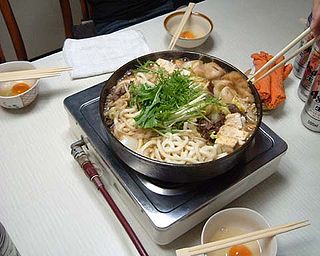
Nabemono, or simply nabe, is a variety of Japanese hot pot dishes, also known as one-pot dishes and "things in a pot".
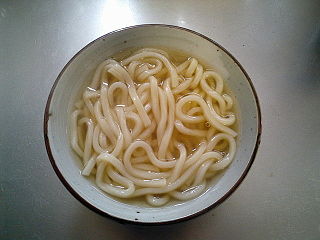
Udon is a thick noodle made from wheat flour, used in Japanese cuisine. There are a variety of ways it is prepared and served. Its simplest form is in a soup as kake udon with a mild broth called kakejiru made from dashi, soy sauce, and mirin. It is usually topped with thinly chopped scallions. Other common toppings include prawn tempura, kakiage, abura-age, kamaboko, and shichimi spice added to taste.

Sukiyaki is a Japanese dish that is prepared and served in the nabemono style.
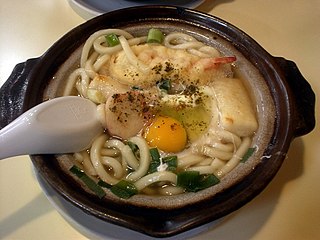
Donabe are pots made out of a special clay for use over an open flame in Japanese cuisine, and in the case of semi-stoneware Banko ware of high petalite content. Often, the food is cooked at the table on a gas burner for various nabemono dishes such as shabu-shabu and dishes served simmering including nabeyaki udon. They are sized by sun, one of the Japanese units of measurement.
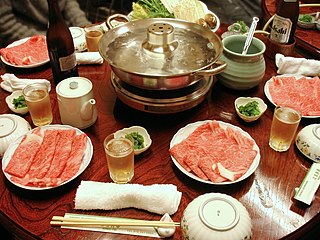
Shabu-shabu is a Japanese nabemonohotpot dish of thinly sliced meat and vegetables boiled in water and served with dipping sauces. The term is onomatopoeic, derived from the sound – "swish swish" – emitted when the ingredients are stirred in the cooking pot. The food is cooked piece by piece by the diner at the table. Shabu-shabu is generally more savory and less sweet than sukiyaki, another hot pot dish.

A tagine or tajine, also tajin or tagin is a Maghrebi dish, and also the earthenware pot in which it is cooked. It is also called maraq or marqa.

Clay pot cooking is a process of cooking food in a pot made of unglazed or glazed pottery.
Shabu or syabu may refer to:

Zōsui, or ojiya (おじや), is a mild and thin Japanese rice soup akin to a rice-based vegetable soup. It is made from pre-cooked rice and dashi or water seasoned with either soy sauce or miso and cooked with other ingredients such as meat, seafood, mushrooms, and vegetables. It is generally served to those who are sick or otherwise feeling unwell, and is usually only served in the winter.

Jeongol (Korean: 전골) is a Korean-style hot pot made by putting meat, mushroom, seafood, seasoning, etc., in a stew pot, adding broth, and boiling it. It is similar to the category of Korean stews called jjigae, with the main difference being that jjigae are generally made with only a single main ingredient, and named after that ingredient, while jeongol usually contain a variety of main ingredients. An additional difference is that jeongol was originally a dish for upper-class Koreans and members of the royal court, while jjigae was a simpler dish for commoners.

Thai suki, known simply as suki in Thailand, is a Thai variant of hot pot, a communal dish where diners dip meat, seafood, noodles, dumplings and vegetables into a pot of broth cooking at the table and dip it into a spicy "sukiyaki sauce" before eating. Despite the name, the dish only barely resembles Japanese sukiyaki, having more in common with shabu shabu and Chinese hot pot.

Beggar's chicken is a Chinese dish of chicken that is stuffed, wrapped in clay and lotus leaves, and baked slowly using low heat. Preparation of a single portion may take up to six hours. Although the dish is traditionally prepared with clay, the recipe has evolved; for convenience and safety it is often baked with dough, oven bags, ceramic cooking pots, or convection ovens.
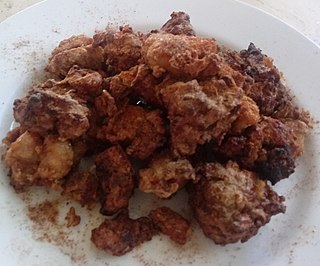
Taiwanese fried chicken, westernized as popcorn chicken, is a dish in Taiwanese cuisine commonly found as a street snack. It is popular at the night markets in Taiwan. It consists of bite-sized pieces of chicken, coated and fried with flour and seasoning mixture. Salt and pepper is the staple condiment, while chili powder, lightly fried basil leaves, and garlic bits are added depending on preference.

Dojo nabe is a Japanese nabemono dish. To prepare the dish, pond loaches are cooked in a hot pot. The freshwater fishes are either killed ahead of cooking or are first soaked in cold sake and then cooked alive.
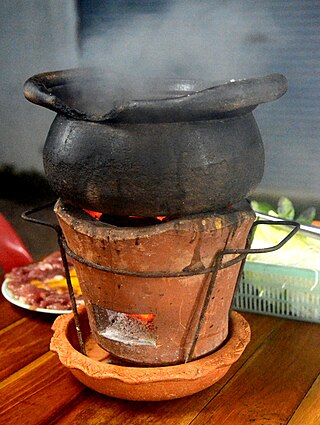
Chim chum is a Southeast Asian street food, popular especially in Thailand. It is traditionally made with chicken or pork and fresh herbs such as galangal, sweet basil, lemongrass and kaffir lime leaves, cooked in a small clay pot on a charcoal stove. It is often served with nam chim.

Hot pot or hotpot, also known as steamboat, is a dish of soup/stock kept simmering in a pot by a heat source on the table, accompanied by an array of raw meats, vegetables and soy-based foods which diners quickly cook by dip-boiling in the broth.

Chongqing hot pot, also known as spicy hot pot, is usually eaten at restaurants, but otherwise is similar to roadside malatang. Chongqing hot pot is similar to the dry stir-fried mala xiang guo (麻辣香锅) which is also eaten in restaurants.

Ghivetch is a traditional Balkan autumn vegetable stew most closely associated with Moldova, where it is a national dish, and Bulgaria. It is traditionally cooked in an earthenware pot called a güveç. It is often made only with vegetables, though some versions include meat, fish, or poultry. The Washington Post in 1985 called it "one of the world's great vegetable melanges". Mimi Sheraton called it "really the last word in vegetable stews".

















